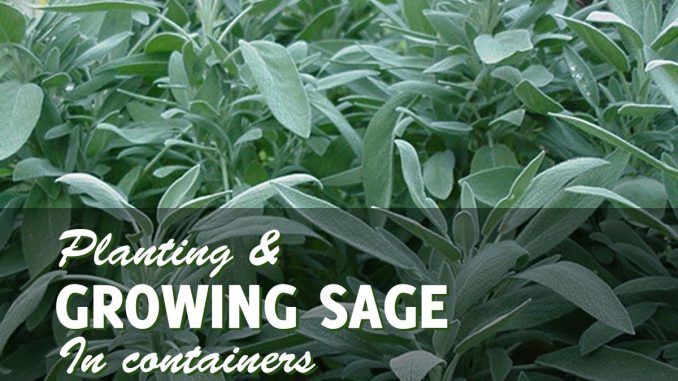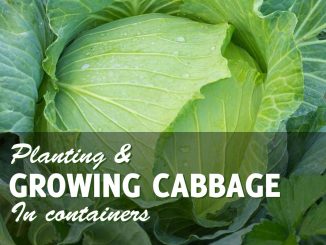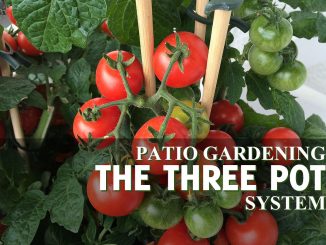
Growing sage in pots is the preferred way of cultivation for gardeners all over the world.
Sage is an herb that can be used for both culinary and decorative purposes. Those who love to cook would definitely want to add sage in their garden. For those who take gardening as a hobby, sage can be a beautiful backdrop or accent to any garden, especially during the blooming season. It is a very hardy plant, and even beginners can start growing sage in containers without any problems at all. There are several varieties that you can try growing in your container garden:
- Common sage – A favorite of cooks, this original sage can be used to enhance the flavors of stuffing and meat dishes.
- Purple sage – The leaves of this variety are purple but still have good flavor
- Tricolor sage – This sage has leaves of varying shades of white, purple or pink, much loved as an ornament as well as a culinary herb
Before You Start Growing Sage in Pots
Sage loves the sun and will do well in zone 5-9 and prefers a lot of sun for ample growth. If you wish to grow sage in the south, then you may need to place your plant in an area that will have the best of the morning sun, but most of the afternoon shade when growing sage in pots. The further south you go, the more protection your sage will need from the heat of the sun.
Choosing the Right Pot to Grow Sage
You will need a pot that is at least 8 inches deep and 8 inches wide when growing sage in containers. Sage can grow up to two feet tall, requiring significant room for root and foliage growth. You have the option of choosing between plastic containers, terracotta pots, wooden boxes, or even decorative containers for your container garden.
The best container for your sage plant will depend upon the zone you are located in.
- Clay pots should be used in colder zones as they aid in wicking excess moisture away from the soil as well as provide insulation to prevent the dirt from getting too cold.
- In warmer climates, you should opt for a plastic pot that will not retain as much heat and will not allow for moisture to escape and over-dry the soil.
- If your climate is mild, then you may opt to grow your sage in wooden pots, which offer a middle ground between terracotta and plastic containers.
Regardless of the type of containers that you would prefer, consider both the size and presence of drainage holes for growing sage in pots. Prevent the soil from drenched with too much water by ensuring there are adequate drainage holes. Too much water will drown the roots, depriving them of oxygen, causing problems with water absorption as well as root rot in your sage.
Once you have placed drainage holes, put broken pieces of terracotta pots, pea pebbles, or coconut husks at the bottom to prevent the soil from eroding. Others go a step deeper by placing a fine mesh of fiberglass to prevent insects from crawling inside the drainage holes, especially if the containers sit on the ground.
Preparing Your Soil Mix for Growing Sage in Pots
Never use ordinary garden soil for growing sage in containers. The problem with regular garden soil is that it contains millions of dormant micro-organisms that can produce diseases. Aside from that, it is mostly made up of clay. Clay absorbs and retains too much water, making it easy to drown your plants.
Potting soil for container gardening can be bought in local garden stores or even online now. Potting soil is created by mixing sterile soil, compost, peat, as well as perlite or vermiculite. This mix is essential to make sure that the growing medium will absorb water and nutrients, but will effectively drain away if given too much water. Some even add sand to help the drainage of the soil.
Adjust the pH of your potting mix to 6.0-6.7 with lime or sulfur that is available in nurseries and garden stores as well as online. The right pH will ensure optimal growth and health of your sage.
Growing Sage in Containers From Seed
You can start growing sage in pots from seeds, although that would mean a longer waiting period. Make sure that the seeds you have bought are fresh, and plant them immediately. Old sage seeds do not propagate very well, if ever. Start growing them indoors in seed trays, although you can also start growing them outside under a cold frame for protection.
Fill the seedling trays with soil and place the seeds on top. Cover with 1/4 to 1/2 inch of compost and water well using a fine mist. Cover with plastic and keep the seedling tray warm and moist. Expect germination within 7-10 days after plotting. Transplant seeds in a container eight weeks after germination or when the seedlings have 2-4 pairs of true leaves.
Growing Sage in Pots From Transplants or Cuttings
You can drastically cut the time you will need until harvesting season if you will start growing sage in containers from transplants or cuttings. You can make your own transplants as above, or buy them from your local nursery or even buy them on amazon. Fill the pot with potting mix halfway and place a good layer of compost, tamping as you go.
Place your transplant on the soil and see if the soil level of your seedling is 2 inches below the lip of the container. Fill up the gaps in the container with soil, pressing out air pockets as you go until you reach the soil level of your transplant and water well. If you started your seedling indoors, you might want to harden them off for two weeks before you transfer your plants outdoors.
You can ask for cuttings from an established sage plant of a neighbor or a good friend and use them for growing sage in containers. Carefully tear off a cutting so that you have a “heel” and dip in on some rooting powder. Dig a hole at the center of your potting soil and place your cutting inside. Cover the hole with soil, water, and your cutting will eventually grow roots and become established on its own.
Care and Harvesting of Your Pot Grown Sage
Always make sure you give enough water when growing sage in pots. It is best to give your plant deep watering every few days instead of giving it shallow watering every day. Fertilize your sage plants with 10-10-10 or 15-10-15 liquid organic fertilizer. You will find that container gardening will require fertilizer more than standard gardening because frequent watering washes out soil nutrients.
Wait for a year after sowing before you harvest your sage leaves. You will have to replace your sage plants every 2-3 years, as this will be their average life span. By harvesting a cutting around spring, you can grow a newly established plant for the next season.
Growing an herb garden ensures you have a constant supply of fresh herbs, on demand, without having to spend money on them! Want to learn about other herbs to grow in containers? Have a look at our article on growing basil in pots.





Be the first to comment